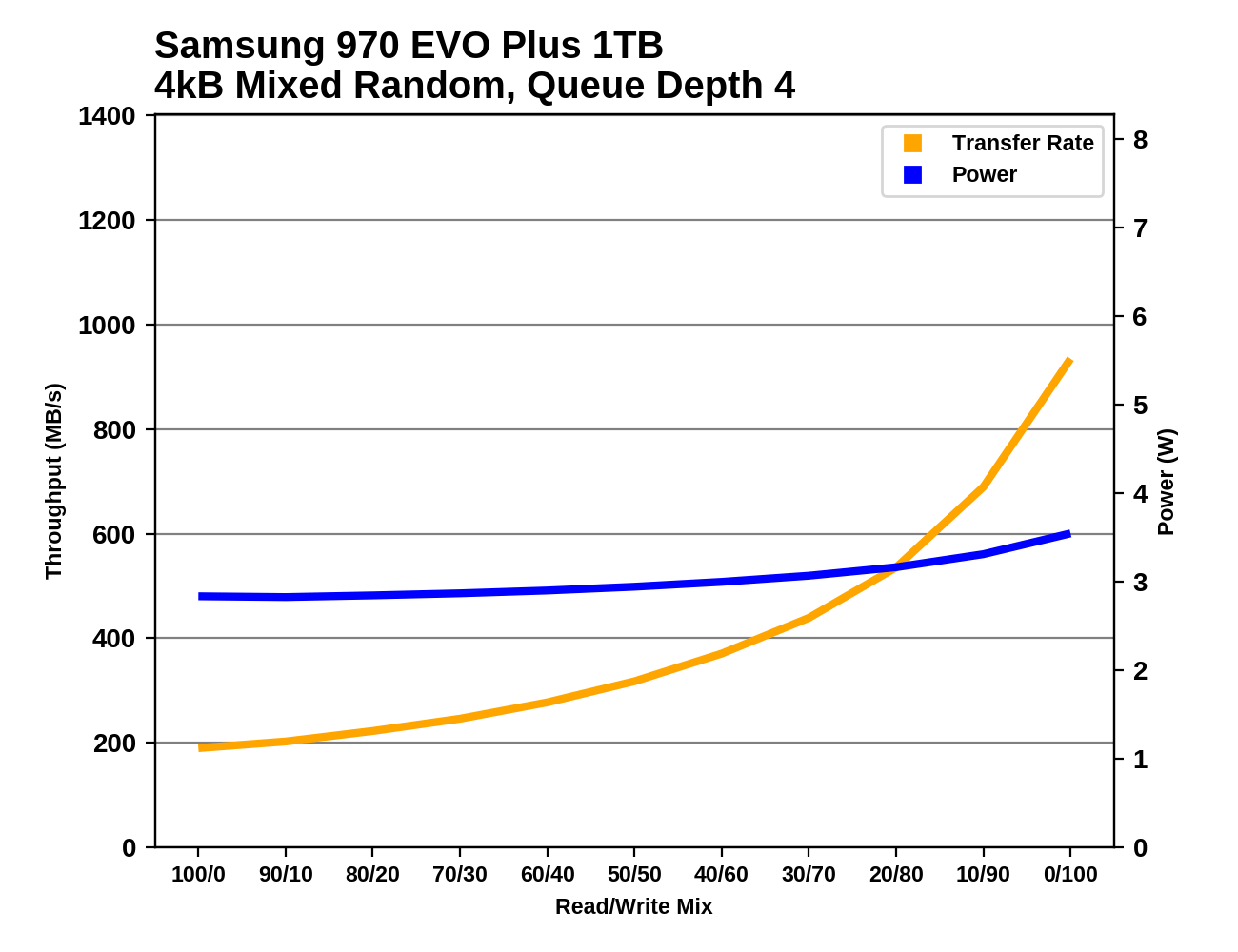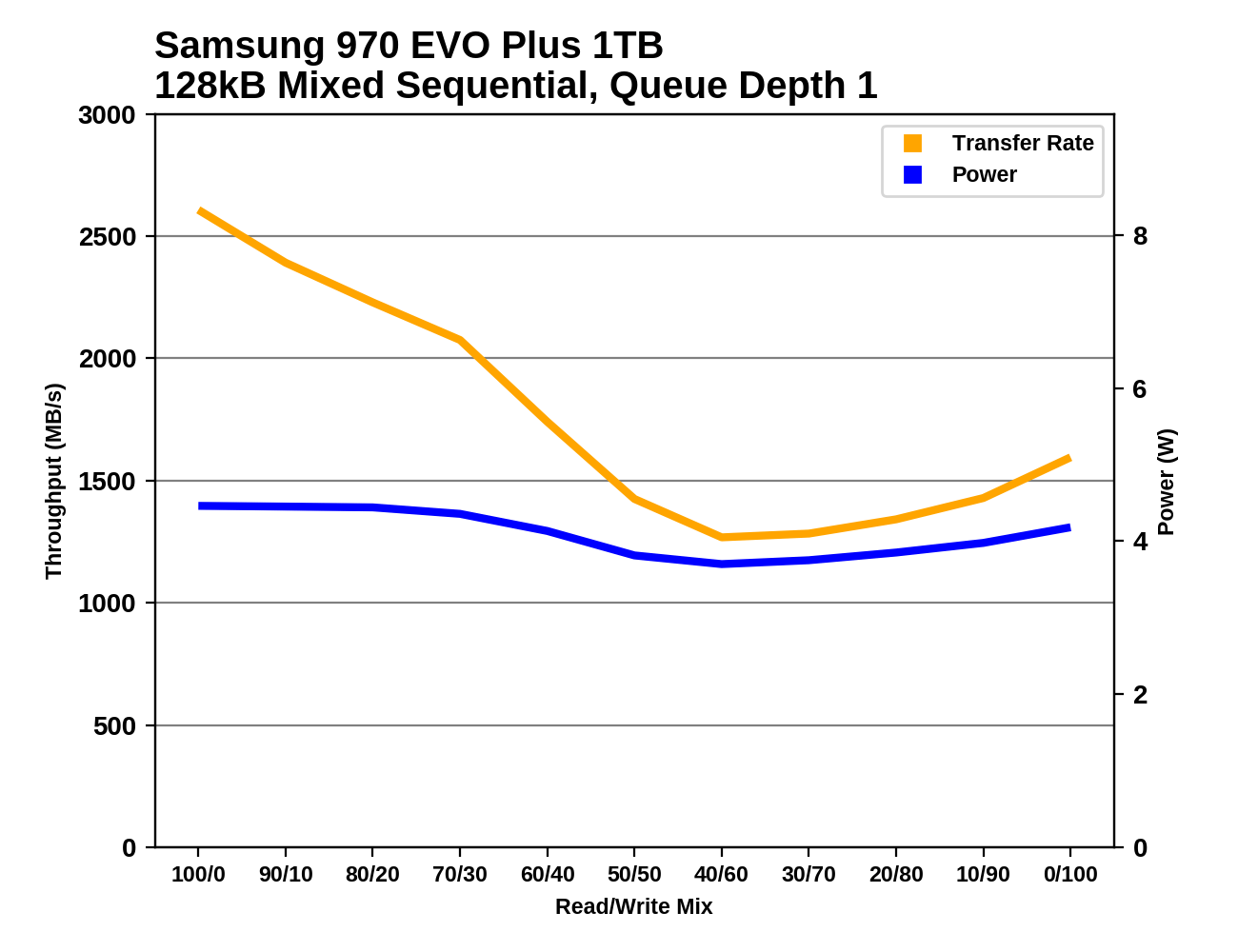The Samsung 970 EVO Plus (250GB, 1TB) NVMe SSD Review: 92-Layer 3D NAND
by Billy Tallis on January 22, 2019 10:00 AM ESTMixed Random Performance
Our test of mixed random reads and writes covers mixes varying from pure reads to pure writes at 10% increments. Each mix is tested for up to 1 minute or 32GB of data transferred. The test is conducted with a queue depth of 4, and is limited to a 64GB span of the drive. In between each mix, the drive is given idle time of up to one minute so that the overall duty cycle is 50%.

The 1TB Samsung 970 EVO Plus slightly improves on its predecessor's performance on the mixed random IO test, to widen Samsung's lead over other TLC-based drives. The 250GB model fares reasonably well, but is again no match for the oversized SLC cache on the 240GB ADATA SX8200.
 |
|||||||||
| Power Efficiency in MB/s/W | Average Power in W | ||||||||
The WD Black SN750 holds on to another power efficiency win and the Samsung 860 EVO SATA SSD is more or less tied with the 1TB 970 EVO Plus. Most of the 250GB-class drives have substantially lower power efficiency scores due to spending much more time working with a full SLC cache.
 |
|||||||||
The 1TB 970 EVO Plus steadily picks up speed as the workload shifts to be more write heavy. The smaller 250GB model's performance flattens out during the middle half of the test as its smaller SLC write cache starts to get in the way, but toward the very end it too speeds up.
Mixed Sequential Performance
Our test of mixed sequential reads and writes differs from the mixed random I/O test by performing 128kB sequential accesses rather than 4kB accesses at random locations, and the sequential test is conducted at queue depth 1. The range of mixes tested is the same, and the timing and limits on data transfers are also the same as above.

The 970 EVO Plus is a bit faster than the original 970 EVO on the mixed sequential IO test, breaking Samsung's own record. The 250GB model finishes ahead of even the 240GB ADATA SX8200 and is only a few percent slower overall than the 1TB HP EX920.
 |
|||||||||
| Power Efficiency in MB/s/W | Average Power in W | ||||||||
The WD Black SN750 and Corsair Force MP510 have the top two power efficiency scores on the mixed sequential IO test, but the Samsung 970 EVO Plus and original 970 EVO are next in line. Both capacities of the 970 EVO Plus require more power than most of their competition, but they put it to good use.
 |
|||||||||
The key to the high overall performance scores from the 970 EVO Plus seems to be that the Samsung drives do not lose performance as quickly when writes are first added to the workload. Many drives have pretty good pure read speed but at 90% or 80% reads they may be only half as fast, while the Samsung 970 EVOs don't see a steep performance drop until around the middle of the test.










35 Comments
View All Comments
ikjadoon - Tuesday, January 22, 2019 - link
Ah, wait. The 970 PRO isn't actually on Bench. I don't think it's been reviewed, right?Kvaern1 - Tuesday, January 22, 2019 - link
Completely not exciting. Don't care about a slight speed increase which no consumer is going to notice in the their daily use anyway. All that matters in the consumer NAND space at this point is bringing prices down, which is very unlikely to happen in a business with no real competition left, read cartel.heffeque - Tuesday, January 22, 2019 - link
Definitely would love to see 4 and above TB SSD drives at HDD prices (or less). Tech isn't there yet I guess.piroroadkill - Wednesday, January 23, 2019 - link
Yeah, you're spot on. To be 100% honest, even a good ol' SATA Samsung 830 is good enough. I've used systems with fast nVME drives, as with "older" SATA SSDs, and I can pretty much say that the difference really isn't that noticeable in most use cases. But price is. Capacity is.stoatwblr - Thursday, January 31, 2019 - link
You might not notice the slowness of 830s, but I do. (840s are better, 850s are great)It all depends on what you're doing.
Mikewind Dale - Saturday, February 16, 2019 - link
"is bringing prices down"Two years ago, I bought a 512 GB Kingston KC400 SATA drive for $160. Today, I can buy a 1 TB Intel 660p QLC NVMe for $125, or a 1TB WD Blue SATA for $125.
So yeah, I'm pretty sure prices are falling. Maybe they're not falling 50% overnight, but falling 50% over two years is pretty darned nice.
RMSe17 - Tuesday, January 22, 2019 - link
If not too difficult, would it be possible to add 970 Pro 1TB results for comparison?kgardas - Tuesday, January 22, 2019 - link
Random read @ Q1 and Q1/2/4 is still nearly the same like on SATA drives (MX500 as reference). Would be great if NVMe vendors would be able to push that to the speed of random write which is noticeable different from SATA. Anybody knows what's holding them back from it?Kristian Vättö - Tuesday, January 22, 2019 - link
Writes can be buffered in DRAM, but reads expose the real latency of NAND.catavalon21 - Tuesday, January 22, 2019 - link
Nice to see you pop in from time to time. You certainly burned the midnight oil on many an SSD review back in the day.